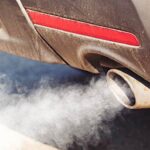Experiencing your car stall just as you’re coming to a stop can be frustrating and even a bit alarming. One common culprit behind this issue is often overlooked but relatively straightforward to diagnose: vacuum leaks. As a vital component of your engine system, vacuum hoses and connections can degrade over time, leading to air leaks that disrupt the delicate balance required for smooth engine operation, especially at idle.
Understanding Vacuum Leaks and Engine Stalling
Your engine relies on a precise mixture of air and fuel to run efficiently. A vacuum leak introduces unmetered air into the intake manifold, leaning out this air-fuel mixture. At higher engine speeds, this might be less noticeable, but when your car idles or decelerates to a stop, the engine is most sensitive to these imbalances. This is because at idle, the engine relies on a stable and consistent vacuum to regulate fuel delivery and maintain a smooth RPM. A vacuum leak disrupts this stability, often causing the engine to stumble, run roughly, or even stall completely when you take your foot off the gas to stop.
Diagnosing a Vacuum Leak: Two Simple Methods
Fortunately, pinpointing a vacuum leak can often be done with a bit of careful observation and a few readily available tools. Here are two effective methods you can use to locate these troublesome leaks:
1. The Ether (Starting Fluid) Method: A Quick but Cautious Approach
One of the quickest ways to identify a vacuum leak is by using starting fluid (ether). This method relies on the highly flammable nature of ether to temporarily enrich the lean air-fuel mixture caused by the leak.
Here’s how to do it safely:
-
Start your engine and let it idle.
-
Listen for a hissing sound. Sometimes, a significant vacuum leak will be audible as a hissing noise, especially when you slightly increase the throttle.
-
Carefully spray small bursts of starting fluid around potential leak areas. Focus on:
- Vacuum hose connections and boots
- Intake manifold gaskets and joints
- Throttle body or carburetor flange gaskets
- Any other vacuum lines or connections
-
Observe the engine’s reaction. If the engine RPM suddenly increases or smooths out after spraying in a specific area, you’ve likely found your vacuum leak! The ether is being sucked into the leak, temporarily correcting the lean mixture and causing the engine to rev up.
Caution: Ether is highly flammable. Use it sparingly, ensure good ventilation, and keep a fire extinguisher nearby. Avoid spraying near hot engine components or ignition sources.
2. The Alternative Spray Method: Using Non-Flammable Liquids for Safer Detection
If you’re uncomfortable using ether, or prefer a less flammable approach, you can use other sprayable liquids like brake cleaner or even water in a spray bottle. This method works on the opposite principle of the ether method. Instead of enriching the mixture, these liquids, when drawn into a vacuum leak, will actually worsen the lean condition or momentarily disrupt combustion, causing a noticeable change in engine idle.
Here’s how to use this method:
- Start your engine and let it idle.
- Spray small amounts of brake cleaner or water around the same potential leak areas mentioned in the ether method (hoses, manifolds, gaskets, etc.).
- Listen for changes in engine idle. If you spray near a vacuum leak, you should hear one of these reactions:
- Engine speed decreases or becomes rougher.
- Engine sputters or momentarily stalls.
Any of these reactions indicates that the liquid is being sucked into a vacuum leak, confirming the location of the problem.
Repairing the Vacuum Leak
Once you’ve located the vacuum leak, the repair is often straightforward. In most cases, it involves replacing a cracked, brittle, or disconnected vacuum hose or gasket. Carefully inspect the area where you identified the leak. Look for:
- Cracks or splits in rubber hoses
- Loose or disconnected hoses
- Hard or brittle hoses that don’t seal properly
Replacing a faulty vacuum hose is usually a simple DIY task. Ensure you use the correct type and size of hose for your vehicle. If the leak is from a gasket, like an intake manifold gasket, the repair might be more involved and could require professional assistance.
Conclusion
If your Car Is Stalling When Coming To A Stop, don’t immediately assume it’s a major engine problem. A simple vacuum leak is a common cause and often easily diagnosed and fixed. By using either the ether or alternative spray methods, you can systematically hunt down these leaks and restore your engine’s smooth idle and prevent those frustrating stalls. If you are uncomfortable performing these diagnostic steps or the repair yourself, always consult a qualified mechanic to ensure proper diagnosis and repair.

